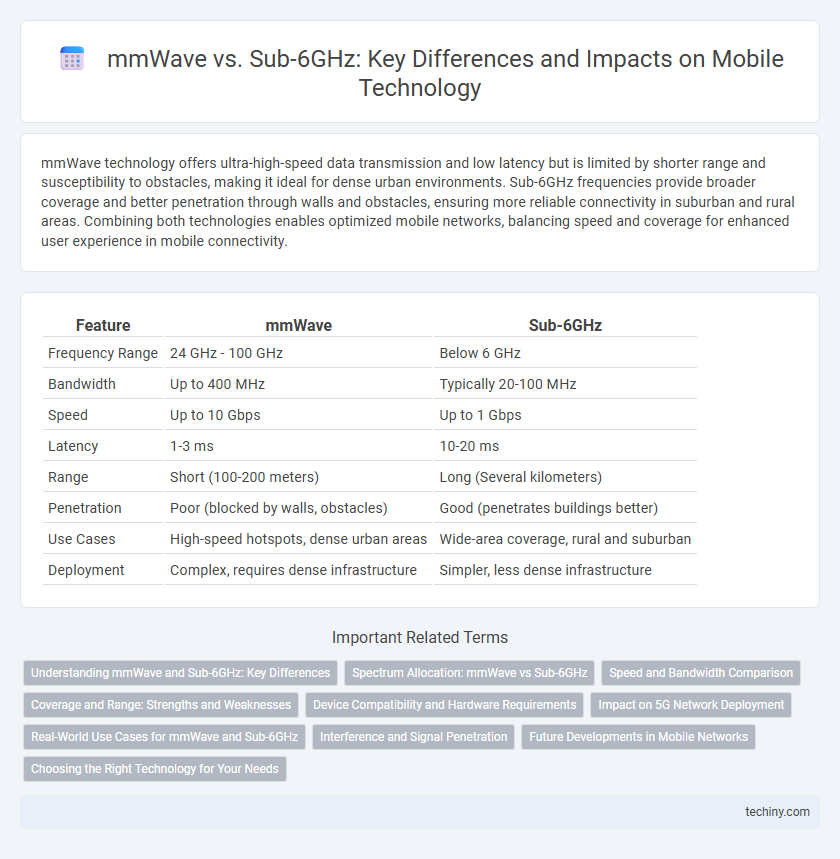mmWave technology offers ultra-high-speed data transmission and low latency but is limited by shorter range and susceptibility to obstacles, making it ideal for dense urban environments. Sub-6GHz frequencies provide broader coverage and better penetration through walls and obstacles, ensuring more reliable connectivity in suburban and rural areas. Combining both technologies enables optimized mobile networks, balancing speed and coverage for enhanced user experience in mobile connectivity.
Table of Comparison
| Feature | mmWave | Sub-6GHz |
|---|---|---|
| Frequency Range | 24 GHz - 100 GHz | Below 6 GHz |
| Bandwidth | Up to 400 MHz | Typically 20-100 MHz |
| Speed | Up to 10 Gbps | Up to 1 Gbps |
| Latency | 1-3 ms | 10-20 ms |
| Range | Short (100-200 meters) | Long (Several kilometers) |
| Penetration | Poor (blocked by walls, obstacles) | Good (penetrates buildings better) |
| Use Cases | High-speed hotspots, dense urban areas | Wide-area coverage, rural and suburban |
| Deployment | Complex, requires dense infrastructure | Simpler, less dense infrastructure |
Understanding mmWave and Sub-6GHz: Key Differences
mmWave operates at extremely high frequencies, typically above 24 GHz, offering ultra-fast data speeds and low latency ideal for dense urban environments but has limited range and poor penetration through obstacles. Sub-6GHz frequencies, ranging from 600 MHz to 6 GHz, provide broader coverage and better signal penetration, making them suitable for widespread mobile connectivity and rural areas. Understanding these key differences helps optimize network deployment strategies by balancing high-speed performance with reliable, extensive coverage.
Spectrum Allocation: mmWave vs Sub-6GHz
mmWave spectrum offers exceptionally high bandwidth, supporting ultra-fast data rates but with limited range and penetration, making it ideal for dense urban environments and short-distance communication. Sub-6GHz spectrum, in contrast, provides broader coverage and better building penetration, making it more suitable for wide-area network deployment and reliable connectivity in diverse terrains. Spectrum allocation strategies favor mmWave for high capacity hotspot zones while Sub-6GHz remains essential for expansive coverage and mobility in 5G networks.
Speed and Bandwidth Comparison
mmWave technology offers ultra-high speeds reaching up to 10 Gbps and supports extremely wide bandwidths exceeding 400 MHz, enabling rapid data transfer ideal for dense urban environments. In contrast, Sub-6GHz bands provide lower speeds of around 1-3 Gbps but deliver broader coverage and better penetration through obstacles with bandwidths typically below 100 MHz. The speed and bandwidth advantages of mmWave make it suitable for applications requiring massive data throughput, while Sub-6GHz ensures more reliable connectivity over larger areas.
Coverage and Range: Strengths and Weaknesses
mmWave technology offers extremely high data speeds but suffers from limited coverage and poor penetration through obstacles, making it ideal for dense urban areas and short-range applications. Sub-6GHz frequencies provide broader coverage and better range with improved signal penetration, ensuring more reliable connectivity in suburban and rural environments. The trade-off lies in mmWave's capacity for ultra-fast speeds versus Sub-6GHz's superior coverage and range consistency.
Device Compatibility and Hardware Requirements
mmWave technology demands advanced antenna arrays and precise beamforming hardware, often limiting compatibility to high-end mobile devices due to its complex design and higher power consumption. Sub-6GHz bands offer broader device compatibility with simpler, less power-intensive components, making them suitable for a wider range of smartphones and IoT devices. Hardware constraints in mmWave require manufacturers to integrate specialized materials and cooling solutions, whereas Sub-6GHz supports more cost-effective and scalable hardware configurations.
Impact on 5G Network Deployment
mmWave frequencies offer ultra-high bandwidth and low latency, enabling faster 5G speeds but face limited range and penetration challenges, requiring dense infrastructure. Sub-6GHz bands provide broader coverage and better building penetration, facilitating wider 5G deployment with more reliable connections. Balancing mmWave and Sub-6GHz technologies optimizes network capacity and coverage, accelerating 5G adoption in urban and rural environments.
Real-World Use Cases for mmWave and Sub-6GHz
mmWave technology offers ultra-high-speed data transfer and low latency, making it ideal for dense urban environments, stadiums, and indoor hotspots where large data capacity is required. Sub-6GHz bands provide broader coverage and better penetration through obstacles, supporting reliable connectivity in suburban and rural areas as well as for mobile users on the move. Real-world deployments show mmWave excels in fixed wireless access and immersive AR/VR experiences, while Sub-6GHz dominates wide-area 5G networks and IoT applications.
Interference and Signal Penetration
mmWave frequencies offer ultra-high bandwidth but face significant challenges with signal penetration, as their shorter wavelengths struggle to pass through walls and obstacles, causing higher interference levels in dense urban environments. Sub-6GHz frequencies provide better signal penetration and lower interference due to longer wavelengths that more easily traverse physical barriers, ensuring more stable connectivity in indoor and suburban scenarios. The trade-off between mmWave's limited penetration and Sub-6GHz's broader coverage is crucial for optimizing 5G network deployments and managing interference effectively.
Future Developments in Mobile Networks
mmWave technology offers ultra-high bandwidth and low latency, making it ideal for future mobile networks that demand extreme data speeds and immersive applications like augmented reality. Sub-6GHz frequencies provide broader coverage and better penetration through obstacles, ensuring reliable connectivity in diverse environments and forming the backbone for widespread 5G adoption. Emerging mobile network developments will likely integrate both mmWave and Sub-6GHz bands to balance performance and coverage, enabling seamless, high-capacity communication for next-generation IoT, autonomous vehicles, and smart cities.
Choosing the Right Technology for Your Needs
Selecting between mmWave and Sub-6GHz technologies depends on your specific mobile connectivity requirements, such as coverage range and data speed needs. mmWave offers ultra-high speeds and low latency suitable for dense urban environments but has limited range and penetration capabilities. Sub-6GHz provides broader coverage and better signal penetration, making it ideal for widespread connectivity and consistent performance in suburban and rural areas.
mmWave vs Sub-6GHz Infographic

 techiny.com
techiny.com